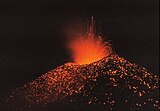Masaya Volcano
| Masaya Volcano | |
|---|---|
Central American Volcanic Belt | |
| Last eruption | 2015–present |
Masaya (
Masaya continually emits large amounts of sulfur dioxide gas (from the active Santiago crater) and volcanologists study this (amongst other signs) to better understand the behavior of the volcano and also evaluate the impact of acid rain and the potential for health problems.
History

The floor of Masaya caldera is mainly covered by poorly vegetated ʻaʻā lava, indicating resurfacing within the past 1,000 or so years, but only two lava flows have erupted since the sixteenth century. The first, in 1670, was an overflow from the Nindiri crater, which at that time hosted a 1-km-wide lava lake. The other, in 1772, issued from a fissure on the flank of the Masaya cone. Since 1772, lava has appeared at the surface only in the Santiago pit crater (presently active and persistently degassing) and possibly within Nindiri crater in 1852. A lake occupies the far eastern end of the caldera.
Although the recent activity of Masaya has largely been dominated by continuous degassing from an occasionally lava-filled pit crater, a number of discrete explosive events have occurred in the last 50 years.
On March 4, 2020, tightrope daredevil Nik Wallenda walked on a steel cable over the caldera.[3]
National park

In 1979, Masaya became Nicaragua's first national park, named Masaya Volcano National Park (Parque Nacional Volcán Masaya). The park has an area of 54 km2 (21 sq mi) and includes two volcanoes and five craters,[4] as well as a range of elevations between 100 and 630 meters above sea level. In the park is a lava tube formed by lava flows; one can find bats and look inside and observe the glowing lava in the dark crater mouth of the volcano.[4]
Geologic setting


Masaya is one of 18 distinct volcanic centers that make up the Nicaraguan portion of the
volcanic range.An ophiolitic suite is found in the
Quaternary volcanic rocks are found mainly in the Nicaraguan
See also
References
- ^ a b "Masaya". Global Volcanism Program. Smithsonian Institution. Retrieved 2009-01-22.
- ^ "Real-Time Multi-GAS sensing of volcanic gas composition: experiences from the permanent Etna and Stromboli networks, Geophysical Research Abstracts, Vol. 11, EGU2009-5839" (PDF). Archived (PDF) from the original on 2016-10-01. Retrieved 2016-09-27.
- ^ Haring, Bruce (March 5, 2020). "'Volcano Live!' Sees Nik Wallenda Appease The Gods – And Anger Some Fans". Deadline. Retrieved March 6, 2020.
- ^ a b "Visiting Masaya Volcano National Park". ViaNica. Archived from the original on 2007-09-21. Retrieved 2007-08-03.
Further reading
- Delmelle, P., Stix, J., Baxter, P.J., Garcia-Alvarez, J. and Barquero, J. (2002). Atmospheric dispersion, environmental effects and potential health hazard associated with the low-altitude gas plume of Masaya volcano, Nicaragua. Bulletin of Volcanology, 10.1007/s00445-002-0221-6
- Rymer, H., van Wyk de Vries, B., Stix, J., and Williams-Jones, G. (1998). Pit crater structure and processes governing persistent activity at Masaya Volcano, Nicaragua. Bulletin of Volcanology, 59, 345–355.
- Williams-Jones, G., Rymer, H., and Rothery, D.A. (2003). Gravity changes and passive degassing at the Masaya caldera complex, Nicaragua. Journal of Volcanology and Geothermal Research, 123(1-2), 137–160.

